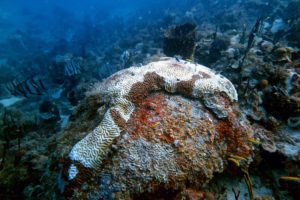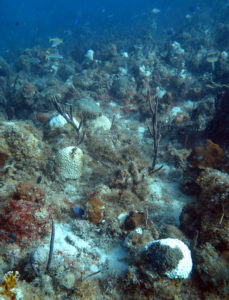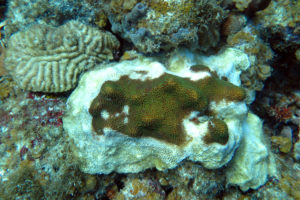A marine scientist has found what is believed to be an especially devastating new coral disease in the waters off the west end of St. Thomas. By Friday, a day after the discovery, V.I. government and private sector interests were working on plans to mitigate its impact.

Known as Stony Coral Tissue Loss Disease, the pathogen was first discovered near Virginia Key, just off the coast of Miami, in 2014 and it has already destroyed masses of corals along the Florida reef track from southeastern Florida through most of the Florida Keys.
Scientists don’t know the precise cause of SCTLD. They do know that it effects an unusually large number of species, that it kills off some far more quickly than other diseases, that it turns its victims a brilliant white, and that it did not die out in the cold waters of winter, as most coral diseases do.
It is not dangerous to humans. However, its long-term consequences may be very detrimental, most obviously to the fishing and tourism industries.
University of the Virgin Islands Professor Marilyn Brandt, an expert on corals, was conducting unrelated research Thursday near Flat Cay off the western end of the Cyril King Airport runway when she came upon a reef showing the distinctive signs of SCTLD.
Further exploration turned up the same disease in nearby Perseverance Bay, where the Miss Opportunity dive wreck attracts snorkelers and SCUBA divers.
“It definitely is very severe in at least one site,” Brandt said Friday.
In 20 years of studying coral – in Florida, in the Caymans, and for about 10 years in the Virgin Islands – Brandt said this is the worst disease she has ever encountered. It is far worse than the infamous coral bleaching that damaged so much of the Caribbean’s coral in 2005 and 2006.
“It’s a very serious situation,” she said. As the name implies, corals actually lose tissue because of the disease and it can take many years for coral to regrow and for a reef to recover.
Although she wasn’t expecting to find the disease when she did, Brandt was not surprised by the sighting.
“We’ve been on the lookout for it,” she said, adding that at a conference in December she learned that it had been seen near St. Martin. It has also been reported in Mexico.
The government is organizing a meeting for next week of the Virgin Islands Coral Reef Advisory Group to address the situation, according to Leslie Henderson, the coral reef initiative coordinator for the Coastal Zone Management division of the Department of Planning and Natural Resources.

The group has representatives from UVI, the National Park, the Nature Conservancy, DPNR, and the National Oceanic and Atmospheric Administration, she said. She expects NOAA officials familiar with SCTLD in Florida to conference into the meeting by phone.
DPNR will also distribute materials to local dive shops alerting people about SCTLD, she said, and is asking people to stay away from the areas where it is believed to be. The thinking is that the disease can be spread easily from one area to another on dive gear or in boat ballast water as well as by the natural flow of sea water.
“It’s notoriously hard to isolate the cause” of coral diseases, Henderson said. And since scientists can’t identify the cause of SCTLD, they can’t use samples to confirm its presence. But neither Brandt nor Henderson, nor any of the other marine scientists who have viewed photos of the St. Thomas sites, have any doubt that it is Stony Coral Tissue Loss Disease they are seeing.
“There’s no cure,” for it, Henderson said. However, “there are things you can do to prevent its spread.”
In Florida, there has been some success with treating effected coral with antibiotics, applied in a kind of paste. There has also been use of “trenching.” In a method somewhat similar to containing a forest fire by burning a line of trees in its path and robbing it of fuel, divers cut away diseased area from the coral as well as a tiny portion of the healthy coral adjacent to it, hoping to stop the spread.

There is also some hope that corals in the V.I. area may fare better against the disease than those near Florida have. Brandt said there have been several incidents of bleaching in Florida waters in the past few years and that likely has weakened the coral.
“Our corals may be more resilient,” she said.
Nevertheless, she and Henderson are bracing for a long fight.






What else travels from Fla. to the Islands? Cruise ships maybe? Not sure how one might disinfect a hull, though.